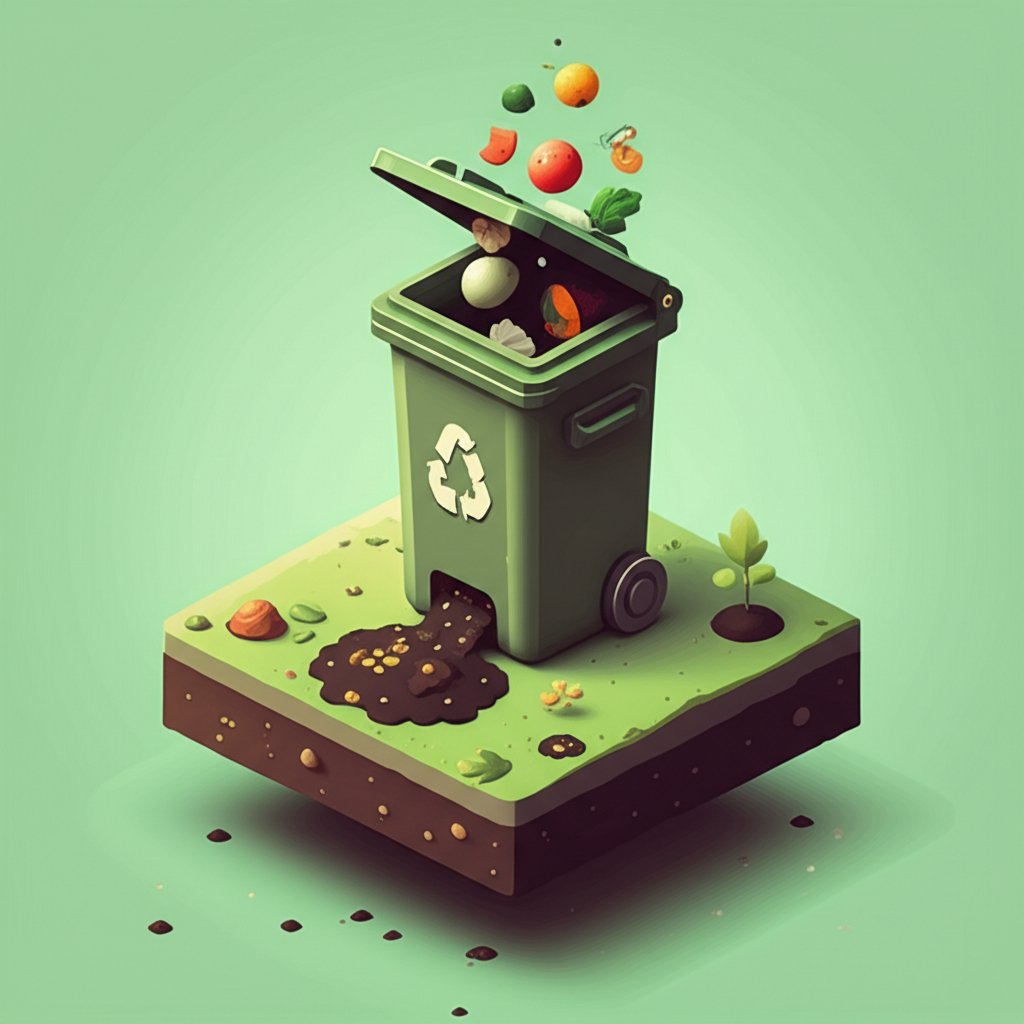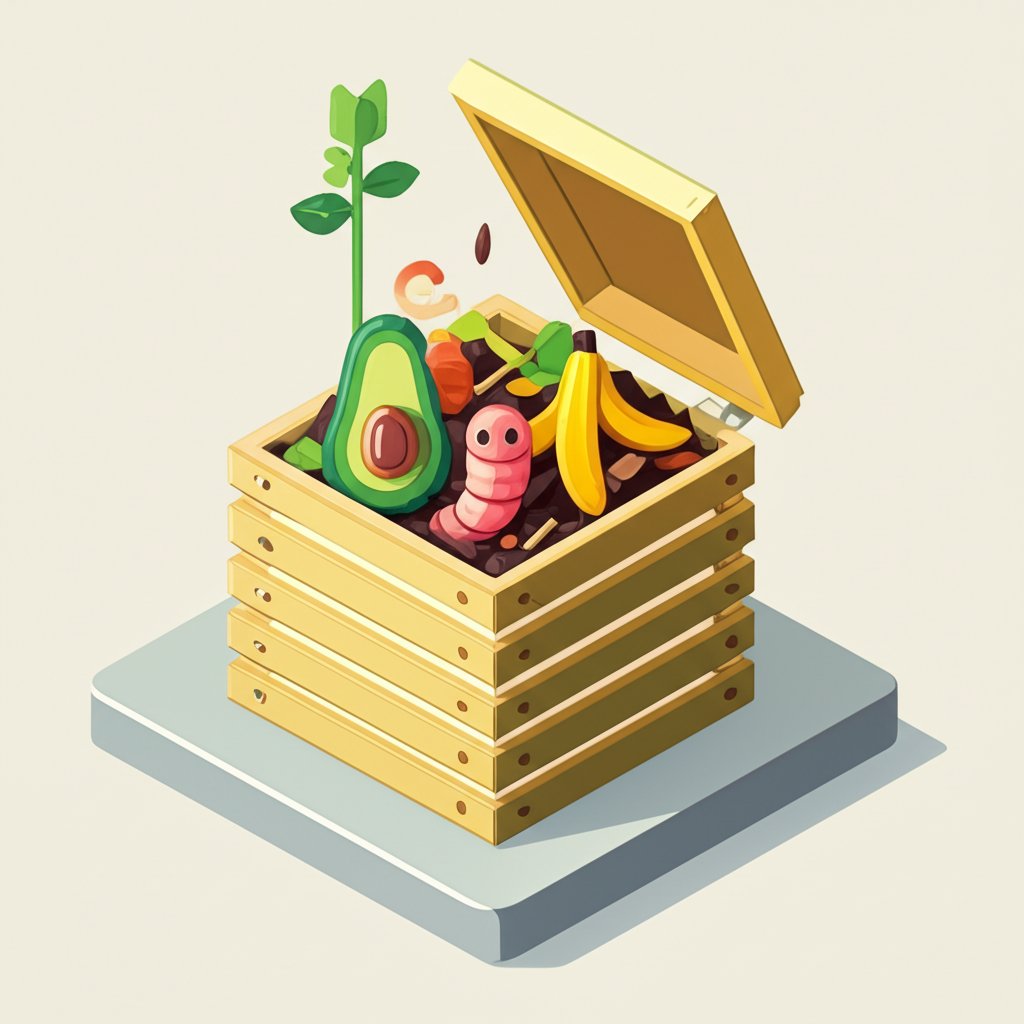In a world increasingly conscious of its environmental footprint, a powerful, yet often undervalued, solution lies in our hands: composting organic waste. This transformative practice transcends simple waste disposal; it’s a cornerstone of sustainable living, converting daily discards into a rich, life-giving resource that revitalizes the earth. By embracing composting, we actively participate in building a greener future, one nutrient-packed handful at a time. This definitive guide will equip you with the advanced knowledge and practical techniques to master the art of composting, unleashing its profound benefits for your garden, your community, and our planet.
Composting is more than just a trend; it’s an ancient, effective method that addresses modern environmental challenges, from reducing landfill volume to mitigating greenhouse gas emissions. It’s a testament to nature’s inherent recycling capabilities, allowing us to mimic and accelerate a process that creates invaluable “black gold” for our soils. Dive in to discover how you can revolutionize your waste, enrich your environment, and contribute to a more sustainable world.
Understanding Composting: The Science Behind Transforming Organic Waste
At its core, composting organic waste is a sophisticated natural recycling process. It emulates the decomposition found in pristine forest floors, where organic materials are meticulously broken down into a dark, crumbly, earthy-smelling substance known as compost. This isn’t magic; it’s intricate biology.
What is Composting? Nature’s Ultimate Recycler
Composting is the controlled decomposition of organic matter by a vast array of microorganisms, including bacteria, fungi, and actinomycetes, alongside macroorganisms like worms and insects. These tireless workers metabolize complex organic compounds, breaking them down into simpler, stable forms. In essence, you are meticulously cultivating an optimal environment – a miniature ecosystem – where nature’s recyclers thrive, transforming what society deems organic waste into a valuable soil amendment. This biological symphony is crucial for the effective, environmentally sound management of our organic waste.
The Vital Role of Microorganisms in Decomposition
The unseen heroes of any compost pile are its microbial inhabitants. Bacteria initiate the breakdown, especially in the early, high-temperature phases of hot composting. Fungi, with their expansive networks of hyphae, are adept at decomposing tougher, woody materials. Actinomycetes, a type of bacteria that looks like fungi, contribute to the earthy smell of healthy compost and break down recalcitrant compounds. These organisms require four key elements to perform their work optimally: carbon for energy, nitrogen for protein synthesis, oxygen for aerobic respiration, and moisture for life-sustaining processes. Understanding this microbial ecosystem is key to mastering the art of composting.
Why Composting Matters for a Sustainable Future: Beyond Waste Reduction
The positive ripple effects of composting extend far beyond your backyard, making it a critical component of sustainable living and a direct path to a greener future. Its environmental, economic, and agricultural benefits are profound and far-reaching:
- Reduces Landfill Burden & Methane Emissions: Food scraps and yard trimmings constitute a significant portion (around 30% by some estimates) of municipal solid waste. Composting diverts these materials, drastically reducing the volume sent to overflowing landfills. Crucially, as
organic wastedecomposes in oxygen-deprived (anaerobic) landfill environments, it produces methane, a potent greenhouse gas many times more damaging than carbon dioxide. Composting, an aerobic process, dramatically lowers these harmful methane emissions, directly combating climate change. - Enriches Soil & Boosts Plant Health: Compost, often called “black gold,” is an unparalleled powerhouse for soil health. It improves soil structure, enhancing aeration and drainage in heavy clay soils while boosting water retention in sandy soils. It slowly releases a balanced array of essential macro and micronutrients, feeding plants naturally and reducing the reliance on synthetic chemical fertilizers, which can harm soil life and pollute waterways.
- Conserves Water & Prevents Erosion: Applied to garden beds, compost acts like a sponge, significantly increasing the soil’s water-holding capacity. This means less frequent watering, making your garden more resilient during dry spells and conserving a precious resource. Furthermore, its stable structure helps bind soil particles, protecting against wind and water erosion and preserving vital topsoil.
- Supports Local Food Systems & Sustainable Living: By enriching local soils, compost helps grow healthier, more robust produce, fostering resilient local food systems and reducing reliance on industrial, transportation-heavy food chains. Farmers utilizing compost are practicing a core tenet of
organic farming, directly contributing to overallsustainable living. Your home compost closes the nutrient loop, connecting your household directly to broader agricultural sustainability efforts. - Fosters Biodiversity: Healthy soil teems with microbial life and beneficial organisms. Compost introduces and nourishes this diverse web of life, supporting a vibrant soil ecosystem that is more resilient to pests and diseases.
The Essential Ingredients: Your Composting Recipe for Success
Successful composting hinges on creating the precise conditions for optimal microbial activity. This involves a balanced mix of four key ingredients, often summarized as “browns, greens, air, and water.”
Balancing Browns (Carbon-Rich) & Greens (Nitrogen-Rich)
The secret to an active, odorless compost pile lies in the carbon-to-nitrogen (C:N) ratio. Microorganisms need both for energy and growth. A general rule of thumb for home composters is to aim for roughly two to three parts brown materials to one part green materials by volume.
Browns: What to Include (Carbon-Rich Materials)
These dry, often woody materials provide the carbon that serves as the microorganisms’ energy source. They also provide structure to the pile, allowing for good airflow.
Greens: What to Include (Nitrogen-Rich Materials)
These fresh, moist materials provide the nitrogen essential for microbial growth and reproduction. They are the “fuel” that heats up the pile.
* Fruit and Vegetable Peels & Cores: Apple cores, banana peels, onion skins, potato peels, celery roots, citrus rinds (in moderation, as excessive amounts can slow decomposition).
* Coffee Grounds and Filters: Excellent source of nitrogen.
* Tea Bags: Remove any plastic staples or non-biodegradable tags.
* Eggshells: Crush them for faster decomposition; they add calcium, which helps buffer acidity.
* Stale Bread/Baked Goods: Break into small pieces.
* Cooked Grains/Pasta: Unseasoned and in small quantities to avoid attracting pests.
* Fresh Grass Clippings: Use in thin layers to prevent matting, which can lead to anaerobic conditions and odors.
* Green Plant Trimmings: From non-diseased plants.
* Spent Flowers: Deadheaded blooms.
The Unsung Heroes: Air and Water
Beyond browns and greens, the success of composting hinges on two vital, yet often overlooked, elements:
organic waste. Lack of oxygen often leads to unpleasant smells.What NOT to Compost: Avoiding Pitfalls and Pests
While the goal is to transform as much organic waste as possible, some materials should never enter a home compost pile. Avoiding these is critical for preventing pests, pathogens, and unpleasant odors, ensuring your sustainable living efforts remain positive.
- Meat, Bones, Fish, and Dairy Products: These attract rodents, flies, and other pests, produce strong putrid odors, and can harbor harmful bacteria that may not be eliminated in typical home compost pile temperatures.
- Fats, Oils, and Grease: Similar to meat and dairy, these attract pests, can cause anaerobic pockets, and slow down decomposition.
- Diseased Plants: Pathogens from diseased plants (e.g., blighted tomatoes, powdery mildewed squash) may survive the composting process and spread to your healthy garden when the compost is used.
- Weeds with Seeds: Many weed seeds can survive the cooler temperatures of a typical home compost pile and infest your garden once the compost is applied. Hot composting can kill some weed seeds, but it’s often safer to avoid them.
- Pet Waste (Dog and Cat Feces): This is a critical point. Dog and cat feces can contain harmful parasites (e.g., Toxoplasma gondii) and pathogens that pose serious health risks. Home composting piles cannot reliably achieve the high, sustained temperatures needed to eliminate these risks. This is a significant distinction from specialized, industrial
composting human wasteor specially designed composting toilets, which operate under rigidly controlled conditions to ensure pathogen destruction. For home composting, avoid all pet waste. - Chemically Treated Wood: Lumber treated with preservatives should not be composted, as the chemicals can leach into your soil and harm plants.
- Synthetic Materials: Plastics, metals, glass, styrofoam, rubber, and other non-organic items will not decompose. Always remove fruit stickers, plastic tags from bread, or staples from tea bags.
- Glossy Magazines/Colored Ink: While most modern inks are soy-based, excessive amounts of glossy paper or brightly colored inks are best avoided, just in case.
- Citrus Rinds and Onion Skins (in excess): While acceptable in moderation, large quantities can slow decomposition due to their acidity and pest-deterring compounds.
Getting Started: Choosing the Right Composting Method for You
Whether you have a sprawling garden, a small patio, or live in an apartment, there’s a composting method suited for your lifestyle and space. Selecting the right technique for your organic waste can significantly impact your success and enjoyment.
Backyard Composting: Piles, Bins, and Tumblers
The most traditional and widely adopted method, backyard composting, offers versatility depending on your effort level and desired speed.
- Cold Composting (Passive): This is the simplest approach, often called “lazy composting.” You simply pile up your
organic wastematerials and let nature take its gradual course. It requires minimal effort—just layering materials—but is significantly slower, often taking a year or two to produce finished compost. This method doesn’t reach high temperatures, so it’s less effective at killing weed seeds and pathogens. It’s like a slow, organic symphony where decomposition unfolds at a relaxed pace. - Hot Composting (Active & Accelerated): For significantly faster results (weeks to months), hot composting demands more active management. This involves intentionally building a pile with the correct carbon-to-nitrogen ratio, maintaining consistent moisture, and regularly turning the pile to aerate it and keep temperatures high (ideally between 130-160°F or 55-70°C). This active maintenance encourages thermophilic bacteria, ensuring a rapid breakdown and effectively neutralizing most weed seeds and plant pathogens. It’s a lively, engaging process often preferred by serious gardeners aiming for a truly
greener future. - Compost Bins: Enclosed structures (e.g., plastic bins, wooden crates, wire mesh cylinders) offer several advantages. They help contain the pile, retain heat and moisture, deter larger pests, and present a neater appearance. They are excellent for managing medium volumes of
organic wasteand are a great entry point into active composting. - Compost Tumblers: These rotating barrels are often mounted on a stand, making turning the compost effortless. They speed up aeration and mixing without manual forking, are typically pest-resistant, and are ideal for smaller spaces or for those who prefer an easier turning method. Tumblers can be very efficient for composting organic waste quickly, often achieving hot composting temperatures.
Indoor & Small-Space Solutions: Vermicomposting & Bokashi
For those without significant outdoor space, innovative methods bring organic waste recycling indoors.
- Vermicomposting (Worm Composting): Worms as Your Partners in Recycling Organic Waste
Vermicomposting utilizes specific species of earthworms, primarily Red Wigglers (Eisenia fetida), to break down kitchen scraps. It’s an excellent method for apartments, small homes, or classrooms, producing nutrient-rich worm castings (vermicompost), an exceptional soil amendment. A well-managed worm bin is odorless, quiet, and produces compost relatively quickly. It’s a fantastic way to engage directly with the process of composting in a small footprint.
- Bokashi Composting: Fermentation for All Kitchen Scraps
Bokashi is a two-step anaerobic (no-oxygen) fermentation process using a special bran inoculated with beneficial microorganisms. All kitchen scraps, including meat, dairy, and oils (which are typically avoided in traditional composting), can be added to a sealed Bokashi bucket. The microbes ferment the food, pickling it rather than decomposing it. After fermentation (1-2 weeks), the pickled
organic wasteis then buried directly in the garden or added to a traditional compost pile, where it rapidly breaks down. It’s an excellent pre-composting solution for dense or difficult-to-compost materials.
In-Ground & Sheet Composting: Integrating Directly into Your Garden
These methods integrate the decomposition process directly into your garden beds, enriching the soil in situ.
- Compost Pits/Holes: A simple method where you dig small holes or a shallow trench in your garden, bury kitchen scraps, and cover them with soil. The materials decompose underground, slowly releasing nutrients directly into the root zone of future plants. This is an easy, low-effort way to manage small amounts of
organic waste. - Trench Composting: Similar to compost pits but involves digging a longer, shallow trench. You fill it incrementally with
organic wasteand cover with soil. This allows materials to decompose directly where plants will grow, building soil fertility over a larger area. - Lasagna Composting (Sheet Composting): A superb no-dig, no-turn method for building new garden beds or revitalizing existing ones. It involves layering “brown” (e.g., cardboard, leaves, newspaper) and “green” (e.g., kitchen scraps, grass clippings, manure) materials directly on the ground. Over time, these layers decompose, creating rich, fertile soil. It’s an excellent technique for tackling significant amounts of
organic wasteand establishing new planting areas, directly contributing tosustainable living.
Mastering Your Compost Pile: Tips for Optimal Decomposition
Regardless of the method you choose, maintaining the right conditions is key to transforming organic waste efficiently. Becoming adept at reading your pile will turn you into a composting expert.
Maintaining the Ideal Environment: C:N Ratio, Moisture, and Aeration
The interplay of carbon, nitrogen, water, and oxygen is delicate but crucial for active decomposition.
Speeding Up Decomposition: Techniques for Faster Compost
While nature works at its own pace, you can certainly give it a nudge to accelerate the process of turning organic waste into valuable compost.
organic waste, the greater the surface area for microorganisms to colonize and break down. Shred leaves, chop vegetable scraps, and break up cardboard into small pieces.Troubleshooting Common Composting Challenges
Even seasoned composters encounter issues. Understanding how to diagnose and manage common problems will save your pile and keep you on track for a greener future.
Addressing Odors: When Your Pile Smells Foul
A healthy compost pile should smell earthy and pleasant. Foul odors are a clear sign of an imbalance.
* Solution: Add a generous layer of dry “brown” materials (straw, dry leaves, shredded cardboard) and turn the pile thoroughly to introduce oxygen.
* Solution: Add browns, turn, and ensure proper drainage at the base of the pile. Check if your bin has adequate ventilation holes.
Pest Prevention: Keeping Unwanted Guests Away
While beneficial insects are welcome, rodents, flies, and other pests are not.
* Solution: Always bury fresh “green” materials (especially kitchen scraps) under at least 6-8 inches of “browns” or finished compost.
* Solution: Never add meat, dairy, or oils to your pile. Use an enclosed composting bin with a secure, heavy lid. Hot composting (maintaining high temperatures) helps deter them.
* Solution: Moisten the pile and turn it.
Sluggish Breakdown: Reviving a Slow Pile
If your pile isn’t heating up or breaking down, it’s often due to one or more missing elements.
* Symptoms: Materials look crispy, feel dry, little to no decomposition.
* Solution: Add water gradually until it feels like a wrung-out sponge, turning as you add.
* Symptoms: Pile is mostly dry, brown materials, little heat, slow breakdown.
* Solution: Add more fresh grass clippings, kitchen scraps, or coffee grounds.
* Symptoms: Pile is compacted, potentially smells sour or putrid, no heat.
* Solution: Turn the pile more frequently and ensure proper structure with bulky browns to allow airflow.
* Symptoms: Materials are intact, taking a very long time to break down.
* Solution: Chop or shred materials into smaller pieces before adding.
Maintaining the right balance of C:N ratio, moisture, and aeration is an ongoing process. Regularly checking your pile’s temperature, moisture, and smell will help you become adept at managing it. Don’t be afraid to experiment and adjust as needed. The journey of composting organic waste is one of continuous learning and adaptation.
The Broader Impact: How Composting Fuels a Greener Future

The finished product of composting organic waste is a true marvel – a dark, crumbly, nutrient-rich soil amendment that underpins the principles of sustainable living. Its impact extends beyond individual gardens, influencing ecosystems, economies, and our collective journey towards a greener future.
Empowering Sustainable Living Through Organic Waste Management
Composting directly empowers individuals and communities to take control of their organic waste, transforming a liability into an asset. This act of responsibility fosters a deeper connection to natural cycles and promotes resourcefulness.
sustainable living.Economic & Community Benefits: Beyond the Garden
The benefits of widespread composting extend into economic and community spheres.
organic waste from landfills reduces tipping fees and transportation costs for local governments, freeing up resources for other community services.Global Significance: A Step Towards Climate Resilience
On a global scale, effective composting organic waste is a tangible step towards mitigating climate change and building more resilient environments.
Every pound of organic waste composted is a pound kept out of the landfill and a step closer to a greener future. It’s a simple yet profound act that collectively leads to significant environmental improvements, healthier communities, and a more sustainable living paradigm for all.
Conclusion: Cultivating a Greener Future, One Scrap at a Time

Composting organic waste is far more than just an eco-friendly chore; it is a transformative practice that empowers individuals, families, and communities to directly contribute to sustainable living and a truly greener future. From nourishing our gardens and mitigating the burden on landfills to significantly reducing harmful greenhouse gas emissions, the benefits are profound, tangible, and far-reaching. By taking control of our organic waste, we actively participate in nature’s most fundamental cycle, returning valuable nutrients to the earth and fostering a healthier, more resilient planet for generations to come.
Whether you opt for a simple cold pile in your backyard, a diligent hot heap, or embrace the efficiency of vermicomposting in your apartment, every act of composting makes a measurable difference. Start your composting journey today, transforming your scraps into vital soil, and become an integral part of the movement towards a sustainable world where waste is redefined as a valuable resource. It’s time to unlock the full potential of your organic waste and cultivate a sustainable, vibrant greener future.
FAQ
Q1: What is the primary benefit of composting organic waste?
A1: The primary benefit of composting organic waste is its ability to transform discarded food and yard materials into a nutrient-rich soil amendment. This significantly reduces waste sent to landfills, mitigates potent greenhouse gas emissions (especially methane), improves soil health, conserves water, and supports more sustainable living and agricultural practices, all contributing directly to a greener future.
Q2: Can I compost all types of organic waste at home?
A2: While many types of organic waste are excellent for composting, some should be avoided in a home compost pile. Do not compost meat, dairy, bones, fats, oils, diseased plants, or pet waste. These items can attract pests, create foul odors, and harbor harmful pathogens that typical home composting temperatures cannot reliably eliminate.
Q3: What is the ideal balance of materials for successful composting?
A3: An ideal compost pile requires a balanced mix of “brown” (carbon-rich) and “green” (nitrogen-rich) materials, typically aiming for a ratio of 2-3 parts browns to 1 part greens by volume. Additionally, the pile needs consistent moisture (like a wrung-out sponge) and adequate aeration (oxygen), achieved by regular turning.
Q4: How long does it take for organic waste to turn into usable compost?
A4: The time it takes for organic waste to become usable compost varies significantly depending on the method and management. Cold (passive) composting can take one to two years. Hot (active) composting, with proper C:N balance, moisture, and regular turning, can produce finished compost in as little as 2-3 months. Vermicomposting also offers a relatively fast turnaround, often yielding castings in similar timeframes.
Q5: I live in an apartment. Can I still participate in composting?
A5: Absolutely! Even without a backyard, you can contribute to sustainable living. Vermicomposting (worm composting) is an excellent indoor option for kitchen scraps, producing odorless, nutrient-rich castings. Alternatively, Bokashi composting allows for fermenting all kitchen scraps indoors. Many communities also offer municipal or private organic waste collection services, or you can often drop off your scraps at local community gardens or farmers’ markets.
Q6: How does composting contribute to a greener future beyond waste reduction?
A6: Beyond reducing landfill waste, composting significantly contributes to a greener future by sequestering carbon in the soil (acting as a carbon sink), enhancing soil’s water retention capabilities (reducing irrigation needs and conserving water), supporting organic farming and local food systems, and fostering biodiversity in our ecosystems. It minimizes the need for synthetic chemical fertilizers and pesticides, creating healthier environments and more resilient agricultural systems overall.
Q7: What are the main signs of a healthy compost pile?
A7: A healthy compost pile typically exhibits several key signs: it has an earthy, pleasant smell (not foul or rotten), it generates internal heat (especially in hot composting), it attracts beneficial organisms like worms and sowbugs, and the materials are visibly breaking down, moving towards a dark, crumbly texture.










